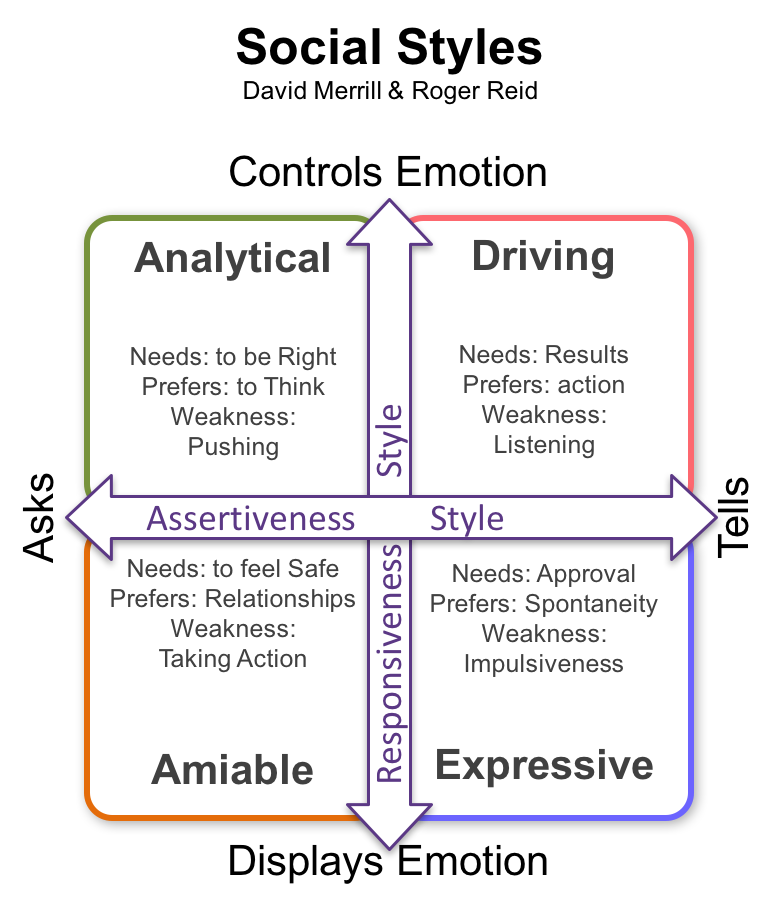Social Styles form a model of personality that focuses on our outer behaviour, rather than the inner you. Its founders described it as ‘the you that’s on display’.
In the early 1960s, two industrial psychologists, David Merrill and Roger Reid wanted to understand whether they could predict managerial, leadership and sales performance. To do this, they explored how people behave in social situations. They chose not to concern themselves with why.
Starting with BF Skinner’s ideas of behaviourism and James Taylor’s structured list of behavioural descriptions, Merrill and Reid discovered that people’s behaviour follows two continua, which they labelled: assertiveness and responsiveness.
Assertiveness and Responsiveness
Assertiveness styles range from ‘asking’ behaviours to ‘telling’ behaviours, while our responsiveness varies from ’emoting’, or displaying our feelings, to ‘controlling’ our emotions.
From these two dimensions, they defined four behavioural styles that we each display. As with other models, we each have our preferences, but can display all of the styles from time to time.
The value of the model lies in using it to assess the people around you, and knowing how to get the best from people with each preference.
Merrill and Reid labelled our ability to adapt to other people’s styles as ‘versatility’.
Four Quadrants: The Social Styles

The four quadrants that the two dimensions of assertiveness and responsiveness create, give the four social styles.
Analytical
The analytical style of interaction asserts itself by asking, rather than telling. It is also characterised by a high level of emotional control. It values facts, logic and accuracy, presenting a disciplined and unemotional – some would say cold – face to the world. This manifests in a deep need to be right about things, and therefore a highly deliberative, data-driven approach to decisions. As with all styles, there is a weakness, which is a lack of willingness to state a position until the analytical person is certain of their ground.
Driving
The driving style is the typical task-oriented behaviour that prefers to tell rather than ask and shows little concern for feelings. It cares more about results. This is a fast-paced style, keen to make decisions, take power, and exert control. Often unco-operative, this is an efficient, results-driven behaviour, the inevitable compromise of which is to sacrifice personal relationships in the short term and, in extremis, in the long term too. The weakness of this style is evident: a frequent unwillingness to listen and accommodate the needs of others.
Expressive
The expressive style is also assertive, but uses feelings to achieve its objectives. The behaviour is highly spontaneous and demands recognition and approval, and favours gut instinct in decision-making. At its best, this style comes across as charismatic, enthusiastic and idealistic. At its worst, however, the expressive style can be seen as impulsive, shallow and even manipulative.
Amiable
The amiable style expresses concern for people above all else. Keen to share emotion and not to assert itself over others, building and maintaining relationships dominate behaviour. These concerns manifest a slow, deliberate pace, coming across as sensitive, supportive and dependable. The corollary is a certain nervousness about, and even a resistance to, change. This arises from a deep need for personal security. The weaknesses of this style are the reverse of the strengths of the opposite quadrant: a low willingness to initiate change, and take action.
Assessment of Merrill and Reid’s Social Styles
Is this just another four box model?
Well, yes and no. In its current form, the company that David Merrill formed, Tracom, uses the model with a third, fully-integrated dimension: versatility. This is about how the four styles manifest in the real world, to meet other people’s needs. It is closely related to ideas of Emotional Intelligence.
Even as ‘just another four box model’, it’s a good one. As a result, it has been widely emulated. A very similar model by Tony Alessandra uses the styles of Thinker, Director, Socialiser and Relater to replace Merrill and Reid’s four social styles, and dimensions of relationship and task orientation, to replace responsiveness and assertiveness.
Both models have considerable power in helping managers understand their behaviours and those of other people around them. And by adapting their style, the models allow managers to get the best from any social situation. And work is, of course, if nothing else… social.

I personally met Dr. Merrill in Columbus Ohio while was working with Union Central Insurance .Ed Emery was my boss at that time,1999.my closing rate sky rocketed thanks to Dr. Merrill when he gave me copy of his book.
Thanks, Jon. It’s always good to add to the oral history.